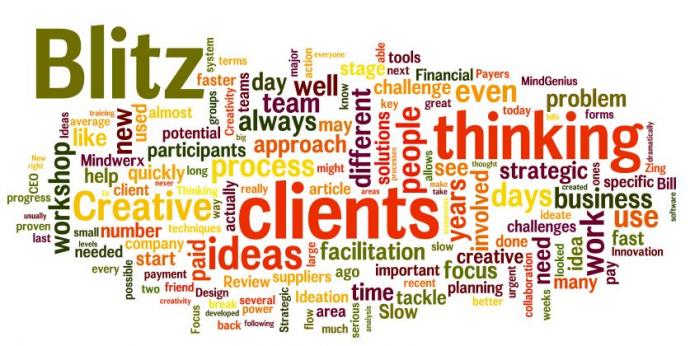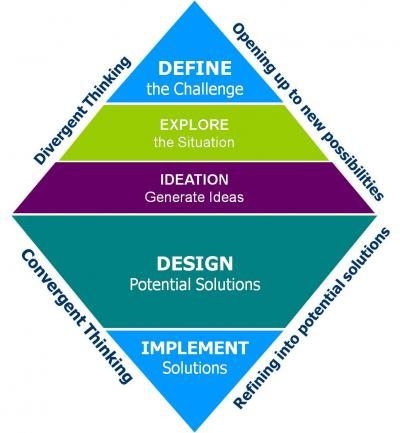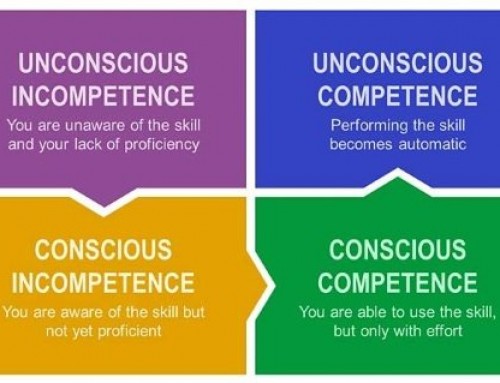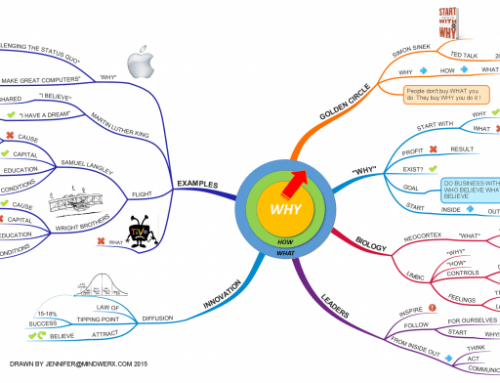 In recent months we’ve had an increasing number of requests from clients to facilitate strategic thinking sessions for them, most often with the senior leadership team, or to run some of our Critical & Creative Thinking workshops with managers as a pre-cursor to their strategic planning process. And it’s been gratifying to see the progress those we work with make in such a short time.
In recent months we’ve had an increasing number of requests from clients to facilitate strategic thinking sessions for them, most often with the senior leadership team, or to run some of our Critical & Creative Thinking workshops with managers as a pre-cursor to their strategic planning process. And it’s been gratifying to see the progress those we work with make in such a short time.And a recent Australian Financial Review article about slow paying clients reminded me of a facilitation I did not long ago, in which I used a Creative Blitz approach to help a clinet rapidly and effectively address what had become a major problem. In the end it may have saved their business.
 So in this article I thought I’d share a few insights into what we’re noticing is most important to organisations today, and tell you about the Creative Blitz approach we use to help teams collaborate better, think more strategically and creatively, and make progress faster than they ever thought possible.
So in this article I thought I’d share a few insights into what we’re noticing is most important to organisations today, and tell you about the Creative Blitz approach we use to help teams collaborate better, think more strategically and creatively, and make progress faster than they ever thought possible.
“Thanks Bill, we did in 4 hours today what normally takes us 2 days, which meant that in just one day we were able to advance our thinking well beyond the short term to actually see where we’re going over the next few years. Fantastic.” CFO, Water Services Company
The Challenges Being Faced
Clients are telling us, and it’s easy to see this reflected in papers like the Financial Review, that they are facing three major strategic challenges today, which are:
- The urgent need to increase workforce productivity
- The urgent need to embrace new opportunities faster and more creatively
- The urgent need to ensure managers and staff focus on what’s important
Of course what these add up to is a desperate need to innovatively improve every aspect of their business so costs can be managed, opportunities seized and returns (profits) improved.
And it needs to be done fast!
So essentially then leaders at all levels need and want to:
- Create a culture of continuous improvement, where every aspect of their operations are understood, managed, and improved where required, by everyone at every level. They become ‘lean’ with high levels of productivity
- Create an environment where creativity flourishes so opportunities to innovate are sought and pursued in every area of the organisation. They become opportunity seeking.
- Give employees at all levels the wherewithal to deal with information overload. They know what to work on, when and how – without being diverted or swamped.
The Creative Blitz to Rapidly Increase Productivity
This is an approach to Strategic Thinking we’ve used in facilitations for over 12 years in a wide variety of scenarios, with small executive teams right up to cross-functional groups as large as 80 participants from every area of the business. The key to this technique is Focus and Planning, and to then engage a process for highly collaborative creative thinking directed at the heart of the challenge.
This is exactly why clients contact us, and when they do we always rely on proven thinking processes and tools we know work, and work fast. We call this type of facilitation a Creative Blitz – basically we plan and prepare well to get high intensity collaboration from the team when they come together. The goal of a Blitz is to ‘break the back’ of the problem with strategic and innovative thinking, that allows the more detailed planning process to be accelerated in the days and weeks following the strategic thinking. We know there is a BIG difference between Strategic Thinking and Strategic Planning, and the Blitz is about the thinking so innovative new approaches can emerge.
As I said at the start, a recent article in the Australian Financial Review about slow paying clients reminded me of a Blitz facilitation I did not that long ago to address what was becoming a major challenge for them. The Financial Review article said that research by Dun & Bradstreet showed that almost 54 days is the average time it takes for an invoice to be paid. That’s the average, so in many cases it can be much longer than this. And the pain is really being felt by small and medium sized businesses, such as our client.
They were a manufacturing and distribution business with about 350 people, who supplied large corporate clients and government departments at City, State and Federal levels. Because they needed to buy in stock for manufacturing they were highly dependent on cash flow, and had managed reasonably well for many years even though clients were slow to pay – usually 30-45 days.
But in the last few years, with the economic crisis hurting everyone, they were under more and more pressure to pay their bills faster at the same time the banks were reducing overdraft limits, and their big clients paid their bills more and more slowly. Many companies are experiencing the same thing.
In this case the CEO of the company was someone I’d worked with a few years ago at another organisation so he sought me out, and we discussed how he could tackle the challenge. His finance people were suggesting giving clients a discount if they paid more quickly, and a few did, but most didn’t. Similarly they gave suppliers a % premium if they would stretch their terms – but again most of these were suffering as well and couldn’t oblige.
So my friend and his company were ‘between a rock and a hard place’ as they say. In response I suggested we tackle the problem hard and fast, with a Blitz Facilitation to break the back of the problem as quickly as possible. I can’t go into all the details here, but in planning a Blitz I always use the Mindwerx divergent-convergent Applied Creativity & Innovation approach. It’s a simple proven guide to such a facilitation, is easily explained, and is always well adopted by workshop participants.
The Mindwerx Applied Creativity & Innovation Approach
Based on the proven Osborn-Parnes Creative Problem Solving concept, this approach guides a facilitation in a way that allows clarity and focus at each stage, while ensuring thinking is first opened up to new possibilities, and designed in to develop potential solutions..

Let me break this down for you, and show you a little of how I used it in an actual Creative Blitz…
Step One – Define the Challenge
Defining the Challenge is done well ahead of the workshop to clarify the vital ingredients in a Blitz:
- The Focus – what will be looked at, and how can we look at it several ways
- The People – who will be involved and how will they be engaged
- The Time – the schedule that allows rapid and creative thinking to emerge
- The Tools – what critical and creative thinking techniques will be used, and what technology is most suited to the facilitation process.
For the problem with Slow Paying clients, my CEO friend and I developed a range of different focus statements to tackle the problem, ranging from simple ones like ‘how do we smooth cash flow and how do we negotiate better payment terms with clients’ to more challenging ones like ‘how might we excite clients so much they want to pay us in full before we even deliver’. The key here was to look at the challenge from a number of different perspectives.
We identified a team of 12 to be involved for a two day off-site workshop – and included 2 clients and 1 supplier representative who were willing to be involved, because in their own way they faced similar challenges, and were eager to see what ideas came up.
For tools I created a fast paced schedule, engaged techniques from Imagineering to lateral thinking, and technologies including our Zing system and MindGenius software to help capture the thinking quickly in a way that promoted focus, collaboration, speed, creativity, better decision making, and faster preliminary design and assessment.
“Nothing can add more power to your life than concentrating all your energies on a limited set of targets” …Nido Qubein, Stairway to Success: The Complete Blueprint for Personal and Professional Achievement
Step Two – Explore the Situation
Exploring the Situation for a serious challenge and Creative Blitz almost always involves serious investigation, research, analysis of the issues and more, that is shared with participants prior to the Blitz, and confirmed at the start of a Blitz workshop. This exploration can take many different forms.
One Blitz Jennifer and I did several years ago, took about a month to prepare and involved surveys, process mapping, financial analysis and even in-factory and in-store tours by the 50 people who participated on the 3-day Blitz workshop.
This group came from every involved functional area, and we had experts and colleagues from similar overseas operations. The resulting ‘fact pack’ was distributed to participants a couple of weeks prior, so that when they arrived at the Blitz we only needed to do a fairly quick review and Q & A, and they got straight into Ideation and Design. The result was the identification of projects to improve operations to the tune of $100M to be completed over twelve months.
For the Slow Payers Blitz we documented a list of all clients and suppliers, how long we had been associated, their payment history over the last two years, and even looked at their suppliers and their competitors. We created spread sheets to model different payment options, looked at the nature of the people the company dealt with, and even examined clients’ public business plans, mission and values statements (it was amazing how many said they valued teamwork, but treated suppliers like the enemy).
“Information is a source of learning. But unless it is organised, processed and available to the right people in a format for decision making, it is a burden, not a benefit.”
… C William Pollard, ServiceMaster Corporation
Step Three – Ideation to Generate New Ideas
Ideation to Generate New Ideas can only be done after the focus is clear and participants are ‘on the same page’ with what has been revealed in the explore phase. But once that is set – the flow of ideas is tightly directed and free flowing. We almost always use technology such as our Zing team collaboration system, or with smaller groups MindGenius software. The aim in this stage is a quantity of new ideas to have the team work with.
When set-up well, Ideation is very exciting for those involved. With the Slow Payers Blitz we started with about 8 different Focus Statements to ideate both broadly and very specifically. We also always find one idea prompts the need to ideate to the next level. For example an initial idea from a broad ideation may be to ‘establish a closer relationship with key people within client organisations’. This would then prompt us to ideate on how to do that, etc. This is where our Zing system comes into its own as it can cascade down seven levels. In the ideation stage the goal is quantity of ideas.
“It is the function of creative people to perceive the relations between thoughts, or things, or forms of expression that may seem utterly different, and to be able to combine them into some new forms – the power to connect the seemingly unconnected.”
…William Plomer, Novelist and Poet
Step Four – Design Potential Solutions
Design of Potential Solutions is the most satisfying part of the process. Because we all know that ideas are almost never solutions, this is when ideas start to come together to into real tangible ways of moving ahead. In this stage we use Harvesting and Idea Development methods to start to converge the thinking onto potential areas of interest. These then proceed to the next stage of design thinking, which may be done at the workshop (usually the second day), or back at work by action teams allocated responsibility to do so.
With our Slow Players Blitz we wanted to finish day two with a number of very specific actionable strategies, so the whole day was focussed on grouping like ideas, developing those that needed more substance, and even adding new ideas suggested by initial ones. This was the Harvesting process, and from it we found 5 potential areas of interest to work on. This left many ideas on the shelf for use later if we needed then, but allowed the team to truly focus and use more creativity to build some really great solutions.
One area the team liked was providing extra value to clients that paid on time, that didn’t actually cost us anything – the aim was for clients to value the relationship and the extra intangible but valuable insights my client offered to clients that paid on time. During the workshop we used MindGenius to have small groups develop and map out different aspects, and start the planning processes. In the end the emerging ideas proved to work a treat, with several of the company’s most important clients shortening trading terms dramatically.
“Ideas are not solutions, they are the raw material of solutions.” … Dr Arthur VanGundy
Step Five – Implement Solutions
Implementation of strategic thinking can mean a number of things, from development of more specific business or project plans, but our preference particularly where the need is for rapid productivity improvement is to assign responsibilities as quickly as possible to actually do something. And we’ve found this always leads to more immediate success, which is backed up with longer term progress and results.
A Creative Blitz never finishes until actions are clearly articulated and those responsible identified and empowered to take action. This certainly happens at any Blitz we facilitate, and with the Slow Payers Blitz, a manageable number of very specific actions were completed in the 3-6 weeks following, and everyone was delighted to see the average time for invoices to be paid drop dramatically from 77 days (they actually had a large client who would not pay for 120 days), to 38 days, with the longest being 60 days. A fabulous result that my CEO friend said may have saved the business.
“An idea that is developed and put into action is more important than an idea that exists only as an idea.” …Dr Edward de Bono, prolific author and a mentor of mine
In Summary
Clearly this is a just an overview of the process we use, but I hope it gives you some ideas on how you might quickly and effectively tackle some of your own challenges. While we traditionally work with clients on big challenges, we also enjoy working with smaller teams, and even entrepreneurial individuals. For all these the basic approach is much the same.
And we haven’t been able to spell out the specific tools we use, but you can get a good feel for this by looking over the training programs we have – we love to train people in these methods and tools so they can tackle real problems really fast.
And for those of you beyond our easy reach (although we have run facilitations and training in more than 10 countries now), we have our Deliberate Creativity & Innovation Online Academy program.
“Bill, I think last week was the beginning of something great for the company. It demonstrated the power and potential of the deliberative creative thinking techniques not only in relation to our divisional functional area but to other divisions. I see their application being of even greater benefit in exploring new products and services, and growing revenues. … Tony, Supply Chain Manager
If you’d like to talk about how we might help you Blitz a serious issues, contact me anytime at bill@mindwerx.com.
Have a great day






Leave A Comment
You must be logged in to post a comment.